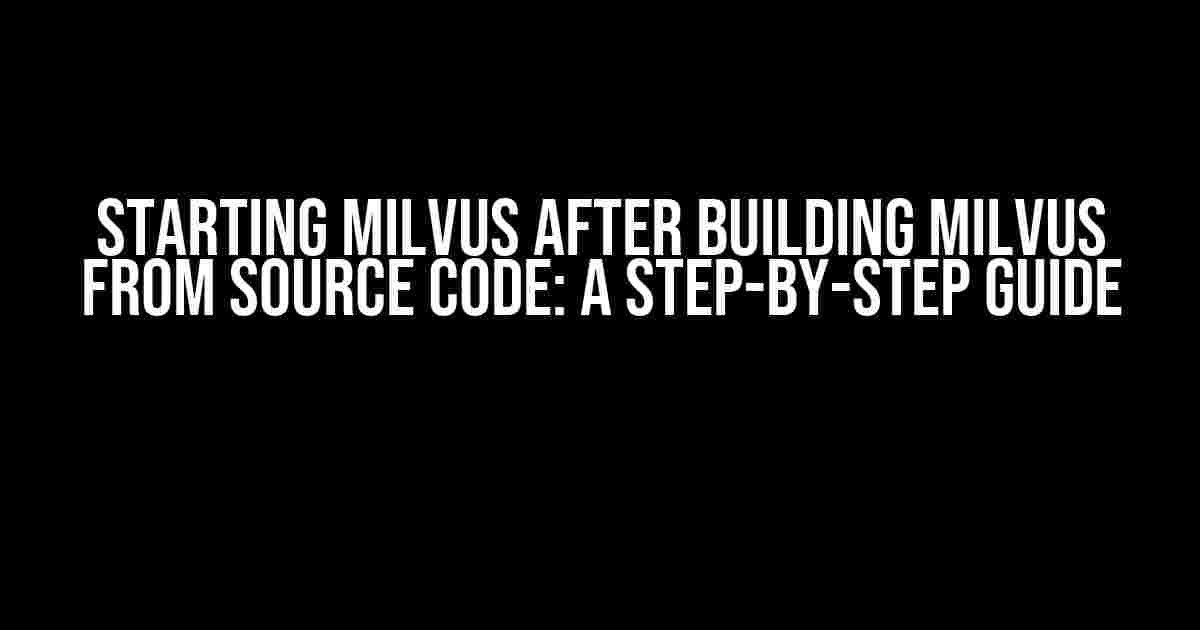Congratulations on taking the first step towards unleashing the power of Milvus, the world’s most advanced open-source vector database! Building Milvus from source code can be a thrilling experience, but it can also be daunting for those new to the game. Fear not, dear reader, for we’re about to embark on a thrilling adventure to get Milvus up and running in no time!
Before We Dive In
Before we start, make sure you have the following prerequisites in place:
- A compatible Linux or macOS system (Windows is not supported for building from source)
- Docker installed and running on your system
- A C++ compiler (e.g., GCC) and the required dependencies installed
- The Milvus source code downloaded and extracted to a directory on your system
Step 1: Build Milvus from Source Code
Now that we have our prerequisites in place, let’s build Milvus from source code. This process can take some time, so grab a cup of coffee and get comfortable!
cd /path/to/milvus/source/code cmake . make -j8
The above commands will configure and build Milvus using the CMake build system. The -j8 flag tells the compiler to use 8 threads, which can significantly speed up the build process.
Step 2: Build Milvus Docker Image
Once the build process is complete, we need to create a Docker image for Milvus. This will allow us to run Milvus in a containerized environment.
docker build -t milvus:latest .
The above command tells Docker to build an image with the tag milvus:latest using the Dockerfile in the current directory.
Step 3: Start Milvus
The moment of truth has finally arrived! Let’s start Milvus and get it up and running.
docker run -d --name milvus -p 19530:19530 milvus:latest
This command starts a new Docker container from the milvus:latest image and maps port 19530 on the host machine to port 19530 in the container.
Step 4: Verify Milvus is Running
To verify that Milvus is running correctly, we can use the Milvus CLI tool to connect to the server and perform a simple query.
docker exec -it milvus milvus cli -h 127.0.0.1 -p 19530
This command opens an interactive shell where we can issue Milvus commands. Let’s try a simple query to verify that everything is working as expected:
milvus> show collections
If everything is set up correctly, you should see an empty list of collections. Congratulations, you’ve successfully started Milvus from source code!
Troubleshooting Common Issues
Don’t panic if you encounter issues during the build or startup process! Here are some common problems and their solutions:
| Issue | Solution |
|---|---|
| Build fails due to missing dependencies | Install the required dependencies (e.g., GCC, cmake) and retry the build process. |
| Docker image build fails | Check the Dockerfile for errors or syntax issues. You can also try rebuilding the image with the --no-cache flag. |
| Milvus fails to start | Check the Docker container logs for errors. You can do this by running docker logs -f milvus. |
What’s Next?
Now that you’ve successfully started Milvus from source code, the possibilities are endless! You can explore the Milvus documentation to learn more about its features and capabilities. Some exciting next steps include:
- Creating a new collection and inserting data
- Performing vector searches and filtering
- Experimenting with Milvus’s advanced features, such as data partitioning and clustering
The Milvus community is also a great resource for learning more about the project and getting involved in its development.
Conclusion
Starting Milvus from source code may seem like a daunting task, but with these steps, you should be up and running in no time! Remember to stay calm, patient, and curious as you explore the world of Milvus. Happy hunting, and don’t hesitate to reach out if you have any questions or need further assistance!
Happy snapping ( err, searching )!
Frequently Asked Question
Got stuck while starting Milvus after building it from source code? Worry not, we’ve got you covered! Here are some FAQs to help you troubleshoot and get started.
Q1: What are the prerequisites to start Milvus after building from source code?
Before you start Milvus, make sure you have Python 3.7 or later, Docker, and Docker Compose installed on your system. You should also have the Milvus source code built successfully.
Q2: How do I start Milvus after building it from source code?
To start Milvus, navigate to the Milvus root directory and run the command `docker-compose up -d` to start the Milvus service in detached mode. You can then use the Milvus CLI or SDKs to interact with the service.
Q3: What if I encounter issues while starting Milvus?
If you encounter issues while starting Milvus, check the Docker logs for errors using the command `docker-compose logs -f`. You can also refer to the Milvus documentation and community resources for troubleshooting common issues.
Q4: How do I verify that Milvus is running successfully?
To verify that Milvus is running successfully, use the command `docker-compose ps` to check the status of the Milvus service. You can also use the Milvus CLI to create a collection and insert some data to verify that the service is working as expected.
Q5: Are there any additional configuration options available for Milvus?
Yes, Milvus provides several configuration options to customize its behavior. You can modify the `milvus.yaml` file to adjust settings such as the data path, log level, and resource allocation. Refer to the Milvus documentation for more information on available configuration options.


